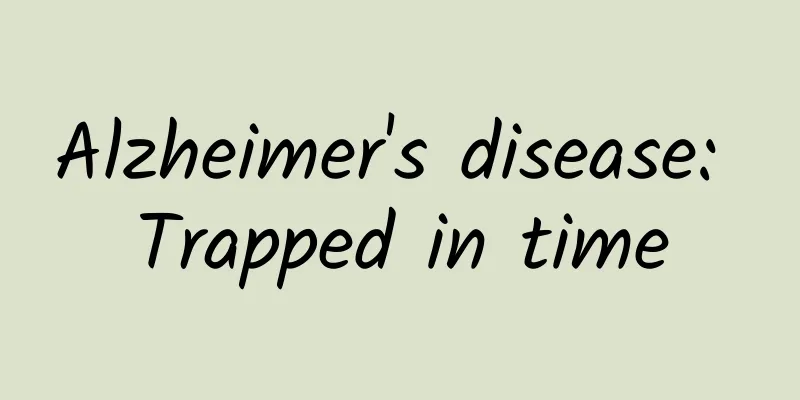Alzheimer's disease: Trapped in time

|
"I feel as if I am losing all my leaves. The branches and the wind and the rain. I… I have nowhere to put my head down anymore." ——《The Father》 Can you imagine yourself in your eighties? Thick eyebrows, white hair, old age, and skin like a crane... Or, I am trapped in the fragments of memory, lost in space, unable to find the direction of time. Everything has become magical, like puzzle pieces scattered all over the ground, pieced together randomly; the connected lines suddenly collapse into points, and each forms a circle. Cycle, loop, chaos, surprise: this place is not this scene, this time is not this moment. The prism refracts and reflects wantonly, reality and memory are constantly alternating and overlapping, true and false, illusions continue. So I lost my support, so I lost everything. So I cried like a child. Studies have shown that Alzheimer's disease is one of the most common diseases among the elderly. The prevalence of Alzheimer's disease in people over 65 years old is about 4.8%, which means that one in every 21 elderly people suffers from Alzheimer's disease. Patients often suffer from cognitive impairment and memory loss, as if they are trapped in a haze, but many people do not realize that this is not a normal degeneration of ability caused by the natural aging process, but an irreversible brain dysfunction. There are about 6 million Alzheimer's patients in China, and currently, the possibility of them being cured is zero. Debunking Alzheimer's Disease Compared to Alzheimer's disease, most people, including me, are probably more familiar with its colloquial name "senile dementia". This word is indeed easy to understand, but to a certain extent, its rough interpretation has also exacerbated the degree of misunderstanding. --"elderly"? One of the studies released by the Alzheimer's Disease Conference in 2019 showed that almost 62% of healthcare providers, including doctors and nurses, around the world believe that this is a normal part of aging and that there is no need or way to treat it. Their views fully represent one of the current misunderstandings about Alzheimer's disease in society. Let us turn back the clock to the last century. In 1901, German doctor Alois Alzheimer observed a female patient named Frau Auguste Deter in a Frankfurt mental hospital. The 51-year-old patient had strange behavioral symptoms and short-term memory loss. In the following years, Alzheimer conducted extensive research on her. He asked her many questions and then asked her if she remembered. Auguste D tried to do it, but she always forgot the rest of the things and kept mumbling to herself that she had lost herself. She could hardly remember the details of her life and often gave irrelevant and incoherent answers to the questions. At the age of 51, he is at the age of knowing the destiny, which obviously does not belong to the category of elderly people. In 2020, at the "Shanghai Science Forum·I Only Know You-Alzheimer's Disease Popular Science Sharing Session" jointly organized by the Shanghai Association for Science and Technology and the Municipal Mental Health Center, expert Li Xia introduced that the youngest Alzheimer's patient she had treated was only 25 years old, not what we usually call the elderly group. Today, Alzheimer's disease is an official term in the medical field, used to describe a common symptom of patients of all ages, and it is more common in the elderly over 65 years old. Alzheimer's disease that occurs before the age of 65 is called early-onset Alzheimer's disease, and Alzheimer's disease after the age of 65 is called late-onset Alzheimer's disease. --"dementia"? In traditional understanding, Alzheimer's disease refers to mental disorder, madness, stupidity and dullness, which means "being old and confused". In fact, this is not the case. Alzheimer's Disease (AD) is a neurodegenerative disease that progresses slowly and worsens over time. Initially, short-term memory is deprived, making it difficult to remember recent events. Sometimes it is forgotten, and sometimes it is dislocated, leaving only fragments that make it difficult to piece together the original appearance of life. As the disease progresses, a series of symptoms begin to slowly emerge, just like a pebble thrown into a lake, breaking the mirror-like surface of the water, causing ripples, layer upon layer, disrupting the person's originally peaceful life, and then sinking to the bottom of the lake, accumulating day by day. Consciousness is confused, naming is impossible, speech is disordered, delusions are misidentified, and the sense of illness is lost: behavioral problems rush in one after another. The saddest thing is to feel that the hourglass of time has turned back, and bit by bit, irreversibly makes people lose their lives, love, and themselves; but they are trapped in it, unable to break free, and can only drift with the sand, accompanied by the dissipation of self-consciousness. Life can no longer take care of itself, like a derailed green train, looking at the world outside of itself running forward, but the throat cannot send out screaming waves, and can only let gravity pull it down, crying hoarsely in the heart, the sense of confusion of time disorder, the sense of desolation of the lonely world, the sense of helplessness... Until the last moment, the body perishes, the dust becomes silent, and everything becomes silent. Genes? Fate? Neither. Or say both. According to the inheritance mode, Alzheimer's disease can be divided into familial Alzheimer's disease and sporadic Alzheimer's disease, of which the latter is more common than the former. Sporadic, as the name suggests, means that the occurrence of Alzheimer's disease in a group is random, just like passing the parcel, no one knows who will be the next one, but the difference is that this time it is not the parcel, but a disease that makes people shudder. Family history is a risk factor for Alzheimer's. In many cases, genetics plays a role, though not as much as age, with its brightly dressed, flamboyantly made-up, and stealing the show on stage, doubling the risk of disease for every five years of age over 60, but it occasionally appears on the big screen or on posters, attracting passers-by to stop and take a look. If a first-degree relative, such as a parent or sibling, suffers from Alzheimer's disease, then the risk of developing the disease will also increase. If two or more first-degree relatives are affected, the risk will be even higher. We are all on the same giant web of beta-amyloid precursor genes, presenilin-1 genes, presenilin-2 genes, apolipoprotein E genes, etc. We are unprotected and unarmed, and there is an abyss below, and we can't see the bottom. Once a corner sinks, the surroundings will inevitably be affected, and we will have to use our hands and feet to try our best to keep our balance. Those who sink into the quagmire may be your grandmother, my grandfather, our parents, you, and me in real life. No matter whether we are afraid or prepared, we will eventually walk this journey of life alone, just like we were thrown into this world alone. At present, the risk genetic variants that have been well studied in Alzheimer's disease are mutations in the β-amyloid precursor gene, presenilin-1 gene, presenilin-2 gene, and apolipoprotein E gene. They affect the processing of amyloid β peptide, suggesting that the aggregation of amyloid β peptide is an upstream event in the pathogenesis of Alzheimer's disease. Just like a waterfall pouring down from the edge of a cliff, if there are too many soil impurities in the upstream, the spring water at the lower end will inevitably become turbid. However, more than 70% of the variation that determines the phenotype is in "peripheral" genes, which account for the vast majority of the heritability of Alzheimer's disease. Such genes have only indirect and weak effects on the expression or post-translational modifications of core gene products and are not very useful for defining the molecular mechanisms driving the phenotype. In 1994, the International Alzheimer's Association designated September 21 of each year as "World Alzheimer's Day", and this year marks the 27th anniversary. In May 2018, the World Health Organization pointed out that Alzheimer's disease and other dementias have ranked fifth among the world's leading causes of death, and it is the only disease among the top ten causes that has no effective treatment. Heidegger said, live towards death. Even though age, genes, and all kinds of factors are like a pair of invisible hands, secretly increasing the force on our necks, strangling our throats, slowly tightening the bag of fate, and depriving us of the right to breathe and think, shouldn’t we still struggle, flutter, and rescue at least once more, trying to free our bodies from the suffocation below the horizontal plane, even if - even if all these efforts are ultimately proven to be in vain. When playing tug-of-war, no matter how weak you are, if you grit your teeth and use all your strength, you can always add some weight to the thick rope. Make 100% effort It has been several years since Alzheimer's disease was first recognized by the world. However, this neurodegenerative disease is still difficult to prevent and there is no effective diagnosis and treatment. Once the disease occurs, it is irreversible. Patients and their families, research scientists, and clinicians can only work together to fight death by all means, seize every moment, and do their best to delay the progression of the disease. Since the early symptoms of Alzheimer's disease can only be detected and reported by the patient himself and his guardian, and Alzheimer's disease is not easy to detect in clinical practice and is not regularly tested, the diagnosis process may be complicated and often not discovered until the late stage of the disease. When walking in the sand, gravel gets into the soles of shoes, which makes people feel that something is wrong from time to time, but they can't tell what is wrong, and they are unwilling to take off their shoes for inspection for this weak, intermittent discomfort, so they turn a blind eye to paralyze themselves and pretend that nothing has happened, but the sand keeps rolling in the shoes. The further you walk, the more sand accumulates, until you can't bear it anymore and the soles of your feet are covered with fine sand. Guidelines jointly directed by the National Institutes of Health and the Alzheimer's Association point out that Alzheimer's disease can be divided into three stages: the first stage is preclinical signs of amyloid protein accumulation or nerve cell changes, but no obvious clinical symptoms; the second stage is mild cognitive impairment, memory loss and other symptoms are more severe than normal people of the same age, but still able to take care of themselves; the third stage, which is the final stage, is the diagnosis of Alzheimer's disease. Therefore, regular visits to the hospital for check-ups are crucial as it not only determines the severity of Alzheimer's disease in patients, but also serves as an indicator to track the progression of the condition. Clinicians make a diagnosis in several steps. First, neuropsychological testing is performed to determine the specific type and level of symptoms presented by the patient. The patient or an informant is evaluated by face-to-face observation and scale assessment, including short-term and long-term memory, attention, reasoning, and problem-solving skills. Then standard blood and urine tests are performed to rule out other medical conditions (such as thyroid disease, depression, etc.) that may cause memory loss and confusion. Finally, magnetic resonance imaging (MRI) and computed tomography (CT) can effectively detect patterns of metabolic changes that indicate neuronal degeneration. When history and routine examinations are not clear for a diagnosis of Alzheimer's dementia or in patients with early-onset dementia, prodromal, or atypical Alzheimer's disease, clinicians should discuss with patients or families the use of positron emission tomography (PET) or cerebrospinal fluid or blood Alzheimer's biomarker testing. At present, researchers generally agree that the pathogenesis of Alzheimer's disease is the deposition of neurotoxic amyloid β peptide in the brain parenchyma, which initiates a pathological cascade reaction, forms neurofibrillary tangles (NFTs), and leads to widespread neuronal loss. The destruction of brain tissue leads to functional impairment and the appearance of dementia symptoms. The main pathological feature is senile plaques (SP) formed by the deposition of β-amyloid protein. In addition to the amyloid peptide hypothesis, there are also explanations such as the microtubule-associated protein abnormality theory, the gene mutation theory, and the final common pathway of neuronal cell death. However, for the treatment of Alzheimer's disease, although some drugs targeting the mechanism have been used clinically, there is still a lack of effective specific methods. The focus of drug research is still on various related symptoms, such as drugs that improve cholinergic neurotransmission, drugs that improve cerebral blood circulation and brain cell metabolism. Once diagnosed, the treatment of Alzheimer's disease will follow the principle of combining drug and non-drug interventions to achieve synergistic effects on cognition, behavior and function. After the patient or family fully understands the possible benefits or risks, cholinesterase inhibitors, memantine, atypical antipsychotics, 5-hydroxytryptamine drugs and even traditional Chinese medicine will be involved in the treatment according to the severity of the disease. Make 10,000 percent effort, because we don’t want to give up - we don’t want to be trapped in an airtight time capsule, oblivious to the past and unable to see the future. References: [1] Sierksma A, Escott-Price V, De Strooper B. Translating genetic risk of Alzheimer's disease into mechanistic insight and drug targets[J]. Science, 2020, 370(6512): 61-66. [2] Michael Jürgs. Alois Alzheimer: Spurensuche im Niemandsland. München: C. Bertelsmann Verlag. 2006. ISBN 978-3-570-00934-5. [3] Se Thoe Ewen,Fauzi Ayesha,Tang Yin Quan,Chamyuang Sunita,Chia Adeline Yoke Yin. A review on advances of treatment modalities for Alzheimer's disease[J]. Life Sciences,2021,276. [4] Nguyen Thuy Trang, Nguyen Thuy Dung, Nguyen Thi Kim Oanh, Vo Tuong Kha, Vo Van Giau. Advances in developing therapeutic strategies for Alzheimer's disease[J]. Biomedicine & Pharmacotherapy, 2021,139. [5] Jakob-Roetne R, Jacobsen H. Alzheimer's disease: from pathology to therapeutic approaches[J]. Angewandte Chemie International Edition, 2009, 48(17): 3030-3059. [6] Barnett JH, Lewis L, Blackwell AD, et al. Early intervention in Alzheimer's disease: a health economic study of the effects of diagnostic timing[J]. BMC neurology, 2014, 14(1): 1-9. [7] Alzheimer's Disease International.World Alzheimer Report 2019[EB/OL]. https://www.alz.co.uk/research/world-report-2019. [8] Alzheimer's Association.2019 Alzheimer's disease facts & Figures[J]. Alzheimers Dement, 2019, 15(3): 321-387.DOI: 10.1016/j.jalz.2019.01.010. [9] JiaJ, ZuoXM, JiaXF, et al. Diagnosis and treatment of dementia in neurology outpatient departments of general hospitals in China[J]. Alzheimers Dement, 2016, 12(4): 446-453.DOI: 10.1016/j.jalz.2015.06.1892. This article is a work of Science Popularization China-Starry Sky Project Produced by: Science Popularization Department of China Association for Science and Technology Producer|China Science and Technology Press Co., Ltd., Beijing Zhongke Xinghe Culture Media Co., Ltd. Author: Chai Yihan, popular science creator Review丨Xiao Yongliang, Vice President of Gansu Nutrition Society |
<<: Warning! These common hormone therapies may increase breast cancer risk
>>: Taboo engraved in human genes - prions
Recommend
What should I check before taking the ring?
We all know that after female friends have an IUD...
Will donating blood make people "weak"? Will donating blood make people fat? The truth is →
In many cases, patients need blood transfusions t...
Can I eat cold noodles during menstruation?
Cold noodles belong to the category of pasta food...
TrendForce: Global smartphone production continues to decline by about 6.6% in Q2 2023, reaching only 270 million units
According to TrendForce, after the global smartph...
Why are my nipples always hard?
Women's nipples can have many conditions. For...
Female hair sweat
People who sweat most easily in the summer are th...
How to wear underwear for big breasts
Girls with larger breasts are more likely to have...
What should I do if the fetus stops growing during the second trimester?
Some pregnant women have problems during pregnanc...
Symptoms of mycoplasma infection in women, these 6 categories are the most common
Both men and women may be infected with mycoplasm...
The best time to have an abortion and what to pay attention to
There are such phenomena in life that many young ...
Will the cervical cyst bleed?
For women, it is important to pay attention to th...
The main function of interferon gel
What is the key function of interferon gel? Recom...
What should I do if my leucorrhea turns into thick snot?
When we have a cold, we often have thick nasal mu...
What are the causes of sudden hair loss in women?
Nowadays people are under great pressure in life....









